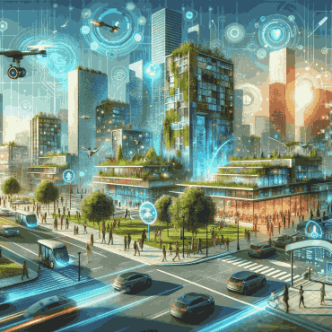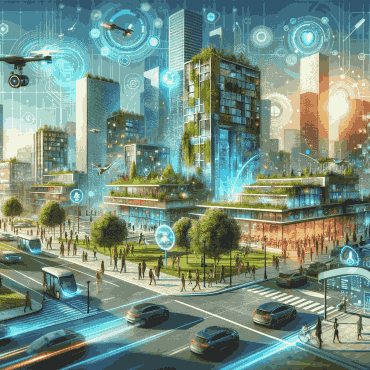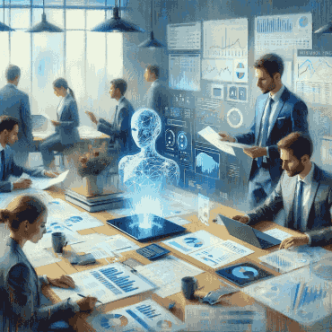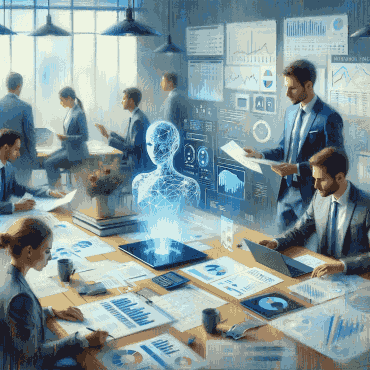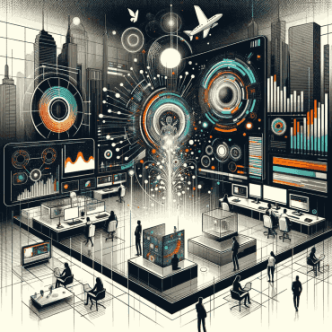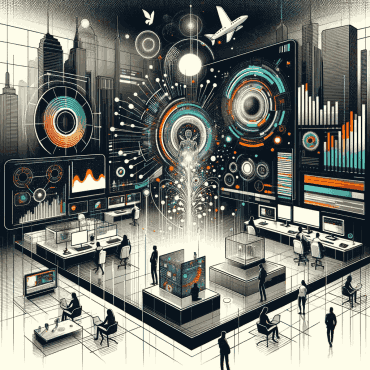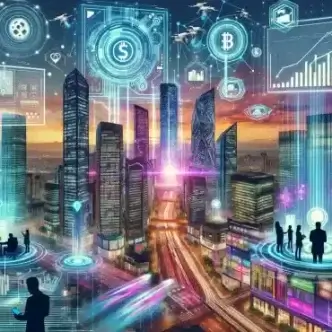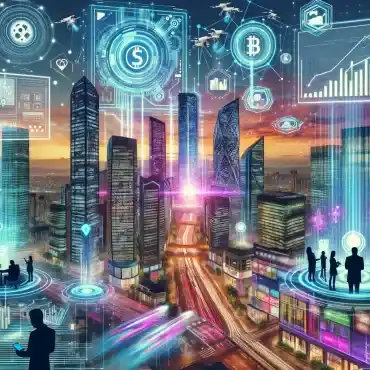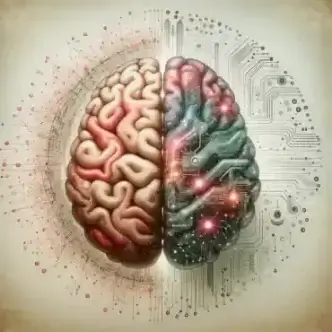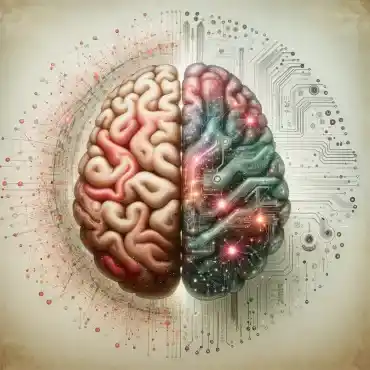As we step into 2024, the tech landscape continues to evolve at a breathtaking pace. This year promises groundbreaking advancements that are set to redefine how we interact with technology. Staying abreast of these tech trends is not just beneficial; it’s essential for anyone looking to thrive in an increasingly digital world.
From generative AI revolutionizing business growth to the advent of spatial computing and the industrial metaverse, these developments herald a new era of innovation and efficiency. In this article, we delve into the most significant tech trends of 2024, each poised to make a substantial impact in the way we work, live, and interact with the digital realm.
Generative AI as a Growth Catalyst
Generative AI, a transformative branch of artificial intelligence, involves algorithms capable of generating new, original content based on patterns learned from existing data. These AI models, such as GPT-3 and LaMDA, excel in tasks like natural language processing, image generation, and even multimodal functions (handling both text and image inputs). They are designed to produce outputs that, while inspired by training data, are unique and innovative. This technology has emerged as a powerful tool for businesses, offering unprecedented capabilities in creativity and problem-solving.
The impact of generative AI on business innovation and growth is profound. It enables companies to automate and optimize creative processes, generate personalized content at scale, and innovate rapidly in product development. For instance, businesses are using generative AI for everything from designing new products to creating marketing content that resonates better with their target audience. This technology is not just a facilitator of efficiency; it’s a catalyst for growth, opening new avenues for revenue and enhancing the ability to respond to market demands with agility.
- Automation and Productivity: Generative AI automates and optimizes a range of business processes, from content creation to data analysis, significantly enhancing productivity and efficiency.
- Personalization: AI’s ability to analyze data and generate tailored content is revolutionizing marketing and customer service, offering highly personalized experiences to customers.
- Innovation in Product and Service Development: Companies are leveraging AI to generate new ideas, designs, and strategies, accelerating the R&D process and fostering innovation.
- Workforce Skill Shift: With routine tasks increasingly automated, there’s a growing need for skills in AI management and creative problem-solving. This shift is prompting companies to invest in reskilling and upskilling initiatives.
- Regulatory and Ethical Considerations: The rise of Generative AI brings challenges, including ethical use and regulation compliance. Businesses must navigate these challenges responsibly to leverage AI effectively.
Spatial Computing and the Industrial Metaverse
Spatial Computing refers to the technology that enables digital and physical realities to merge and interact. It’s about creating a computing environment that exists within our three-dimensional space, allowing for more natural and intuitive interactions with technology. This integration is revolutionizing various sectors by offering new ways to blend computing systems with the physical world.
The Industrial Metaverse refers to the application of metaverse technologies in industrial settings. This includes the use of augmented reality (AR), virtual reality (VR), digital twins, and Internet of Things (IoT) to create immersive, interactive, and interconnected industrial environments. These technologies are transforming traditional industries by enabling simulations, remote operations, and enhanced collaboration.
- Process Simulation and Digital Twins: In complex industrial settings, simulations and digital twins (virtual replicas of physical assets) are proving invaluable. They are connected to real-time data and models via IoT, enhancing the chances of successfully building new operations or optimizing existing ones. The global market for digital twins is expected to grow significantly, with forecasts suggesting a rise from US$6.5 billion in 2021 to US$125.7 billion by 2030.
- Augmented Reality for Interaction with Digital Twins: AR is becoming a crucial medium for interacting with digital twins. It overlays the physical world with a digital layer, creating a shared, immersive internet experience. This has applications in various sectors, including healthcare for training and surgery simulation, and in retail for enhanced customer experiences.
- Infrastructure for the Spatial Web (Web 3.0): The spatial web, or Web 3.0, is expected to integrate digital content seamlessly with physical objects. Innovations like smart glasses will allow users to interact with real-time information in their physical environment, driven by technologies like geolocation, computer vision, and biometric commands.
- Industrial Applications: Enterprises are increasingly focusing on the industrial metaverse for digital twins, spatial simulation, and augmented work instructions. Big tech companies like Meta, Microsoft, and AWS are heavily investing in this space, building tools for creating digital twin content and immersive spaces. These developments are expected to drive the revenue from the industrial metaverse significantly.
- Training and Development: One of the key applications of the industrial metaverse is training. Enterprises are using immersive technologies to expose employees to complex, rare, or hazardous situations virtually, which improves safety and reduces costs.
- Future Predictions and Challenges: As these technologies evolve, they promise to bring more immersive experiences and new interaction methods. However, they also pose challenges like privacy, cybersecurity, and data protection issues that companies need to address proactively.
Beyond Traditional Computing Methods
As we enter 2024, the realm of computing is advancing beyond traditional methods, heralding a new era of technological innovation. Here are some key trends in computing to watch out for:
- Quantum Computing and Post-Quantum Cryptography: Quantum computing continues to evolve, with significant implications for fields like drug discovery and cryptography. As these systems grow in capability, there’s a parallel development in post-quantum cryptography to protect against future quantum attacks. This year, we may see early adoption of post-quantum cryptography as software-based solutions compatible with conventional systems, enhancing data security in anticipation of quantum computing advancements.
- Small and Efficient Language Models: The trend in AI and machine learning is shifting towards smaller, more flexible, and efficient models. These models are tailored to run on installations with limited processing capabilities, which is critical as AI decentralizes. Techniques like Retrieval Augmented Generation (RAG) are making AI outcomes more accessible and efficient, leading to interconnected networks of specialized models, and potentially to multi-agent generative ecosystems.
- AI Advancements and Energy Usage: With the rise in AI and machine learning models, there’s a parallel increase in energy consumption. In response, companies are focusing on energy-efficient AI models, trained on smaller, more precise datasets. This shift is part of a broader trend towards sustainable energy in AI, aligning with global efforts to address climate change.
- Neuromorphic Computing: This emerging technology seeks to mimic the human brain’s architecture in silicon, opening new possibilities for AI systems with human-like learning and decision-making capabilities. Neuromorphic computing could revolutionize tasks such as pattern recognition, contributing significantly to AI’s advancement in 2024.
- Edge Computing for Better Data Outcomes: As generative AI models demand substantial computational resources, edge computing is becoming increasingly important. By processing data close to its source, edge computing aims to reduce latency and enhance real-time operations in areas like autonomous driving and advanced medical imaging.
- The Promise of Space-Based Internet: Companies like SpaceX’s Starlink are working towards providing high-speed internet access globally through satellite networks. This development is particularly significant for remote and underserved areas, potentially changing the way we access the internet.
Going Strong in 2024
With 2024, we have entered a whole new year of unprecedented technological transformations. Get ready to witness a more seamless convergence of various advanced technologies, each promising to revolutionize how we experience and interact with the digital world. And the promise of these developments comes with the responsibility to navigate their challenges thoughtfully, ensuring that as we advance technologically, we also progress ethically and sustainably.
The journey ahead is filled with exciting possibilities, and it’s a privilege to witness and participate in this era of tech breakthroughs. Let’s look forward to a year brimming with innovation, growth, and transformation as we continue to explore and harness the potential of these remarkable technologies.
____________
Written By: Techquity India
